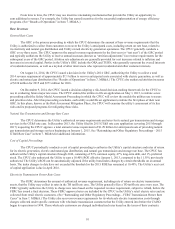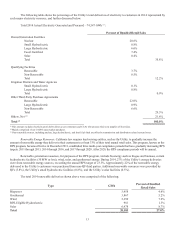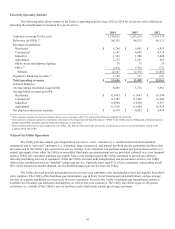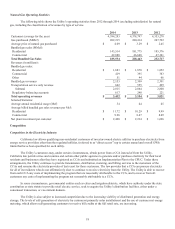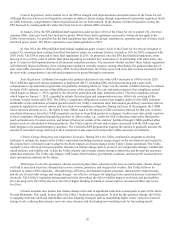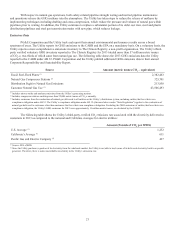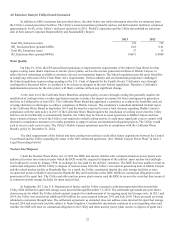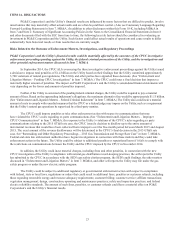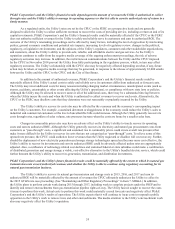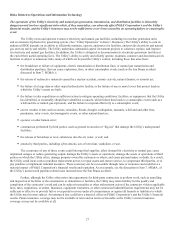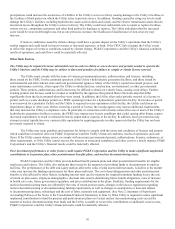PG&E 2014 Annual Report Download - page 28
Download and view the complete annual report
Please find page 28 of the 2014 PG&E annual report below. You can navigate through the pages in the report by either clicking on the pages listed below, or by using the keyword search tool below to find specific information within the annual report.20
Federal Regulation. At the federal level, the EPA is charged with implementation and enforcement of the Clean Air Act.
Although there have been several legislative attempts to address climate change through imposition of nationwide regulatory limits
on GHG emissions, comprehensive federal legislation has not yet been enacted. In the absence of federal legislative action, the
EPA has used its existing authority under the Clean Air Act to address GHG emissions.
In January 2014, the EPA published draft regulations under section 111(b) of the Clean Air Act to control CO2, the most
common GHG, from new fossil fuel-fired power plants. While these draft regulations as presently written do not apply to the
Utility’s power plants, it is possible that the final regulations may affect the design, construction, operation and cost of future fossil
fuel-fired power plants. The EPA is expected to issue final regulations in 2015.
In June 2014, the EPA published draft federal regulations under section 111(d) of the Clean Air Act that are designed to
reduce CO2 emissions from existing fossil fuel-fired power plants on a national basis by as much as 30% by 2030, compared with
2005 levels. The EPA is expected to issue final regulations in 2015. As proposed, once the EPA has finalized regulations, states
have up to two or three years to submit final plans depending on whether they work alone or in partnership with other states, and
up to 15 years for full implementation of all emission reduction measures. It is uncertain whether and how these federal regulations
will ultimately impact California, since existing state regulation currently requires, among other things, the gradual reduction of
state-wide GHG emissions to 1990 levels by 2020. As described below, the Utility expects all costs and revenues associated with
the state-wide, comprehensive cap-and-trade program to be passed through to customers.
State Regulation. California law requires the gradual reduction of state-wide GHG emissions to 1990 levels by 2020.
The CARB has approved various regulations to implement AB 32, including GHG emissions reporting and a state-wide,
comprehensive cap-and-trade program that sets gradually declining limits (or “caps”) on the amount of GHGs that may be emitted
by major GHG emission sources within different sectors of the economy. The cap–and-trade program’s first compliance period,
which began on January 1, 2013, applied to the electricity generation and large industrial sectors. The next compliance period,
which began on January 1, 2015, expanded to include the natural gas and transportation sectors, effectively covering all the
economy’s major sectors until 2020. The Utility’s compliance obligation as a natural gas supplier applies to the GHG emissions
attributable to the combustion of natural gas delivered to the Utility’s customers other than natural gas delivery customers that are
separately regulated as covered entities and have their own compliance obligation. During each year of the program, the CARB
issues emission allowances (i.e., the rights to emit GHGs) equal to the amount of GHG emissions allowed for that year. Emitters
can obtain allowances from the CARB at quarterly auctions or from third parties or exchanges. Emitters may also satisfy a portion
of their compliance obligation through the purchase of offset credits; e.g., credits for GHG reductions achieved by third parties
(such as landowners, livestock owners, and farmers) that occur outside of the emitters’ facilities through CARB-qualified offset
projects such as reforestation or biomass projects. The Utility expects all costs and revenues associated with the GHG cap-and-
trade program to be passed through to customers. The California RPS program that requires the utilities to gradually increase the
amount of renewable energy delivered to their customers is also expected to help reduce GHG emissions in California.
Climate Change Mitigation and Adaptation Strategies. During 2014, the Utility continued its programs to develop
strategies to mitigate the impact of the Utility’s operations (including customer energy usage) on the environment and to plan for
the actions that it will need to take to adapt to the likely impacts of climate change on the Utility’s future operations. The Utility
regularly reviews the most relevant scientific literature on climate change such as sea level rise, temperature changes, rainfall and
runoff patterns, and wildfire risk, to help the Utility identify and evaluate climate change-related risks and develop the necessary
adaptation strategies. The Utility also engages with leaders from business, government, academia, and non-profit organizations to
share information and plan for the future.
With respect to electric operations, climate scientists project that, sometime in the next several decades, climate change
will lead to increased electricity demand due to more extreme, persistent, and frequent hot weather. The Utility believes its
strategies to reduce GHG emissions—through energy efficiency and demand response programs, infrastructure improvements,
and the use of renewable energy and energy storage—are effective strategies for adapting to the expected increase in demand for
electricity. The Utility’s vegetation management activities also reduce the risk of wildfire impacts on electric and gas facilities.
Over the long-term, the Utility also faces the risk of higher flooding potential at coastal and low elevation facilities due to sea
level rise.
Climate scientists also predict that climate change will result in significant reductions in snowpack in parts of the Sierra
Nevada Mountains. This could, in turn, affect the Utility’s hydroelectric generation. To plan for this potential change, the Utility
is engaging with state and local stakeholders and also adopting strategies such as maintaining higher winter carryover reservoir
storage levels, reducing discretionary reservoir water releases, and developing new modeling tools for forecasting runoff.


